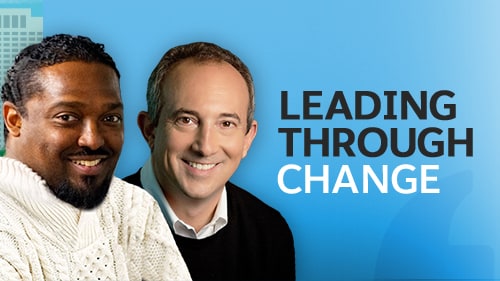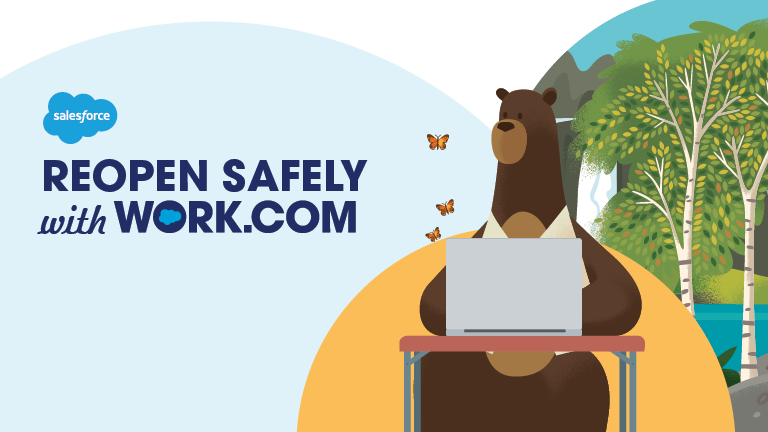Business will be anything but usual as our nation, companies, and communities start to reopen. Many tough questions lie ahead — what to expect, how to prepare, how to stay safe? A phased approach makes sense, but where and how does one start?
In our recent virtual event on how to reopen your business safely, we spoke with several key leaders and experts from the fields of business, technology, and public health and asked them for their thoughts on preparing for reopening while ensuring the safety of employees and the community:
- Kevin Jones, CIO, Indiana Department of Child Services, which administers child support, child protection, adoption, and foster care throughout the state
- Dr. David Agus, one of the world’s leading physicians and the Founding Director and CEO of the Lawrence J. Ellison Institute for Transformative Medicine of USC
- Elizabeth Pinkham, Executive Vice President for Global Real Estate, Salesforce
The following are excerpts from our conversation with Jones, Agus, and Pinkham, in their words. They have been lightly edited for content and clarity.
Kevin Jones — on moving with speed and agility for public safety
Using MuleSoft gives us the ability to paint a vivid picture of information across the entire enterprise. It helps us formulate business intelligence to make evidence-based decisions. This, in turn, allows us to provide positive outcomes for children and their families while ensuring the safety of our teams.
My CFO and director of operations reached out to me and asked: “How can Salesforce solve my problem of managing our supply chain and distribution of PPE and essentials for COVID-19 across 92 county offices? How can Salesforce solve my challenge of workload management and office capacity with the new social distancing requirements, and (contact) tracing for the 4,000 case managers that are still required to go into families and visit their children at their homes or residential placement facilities?
Within eight hours, my team was able to develop a solution that can support our organization as we reenter the workplace. We exceeded expectations. It’s been invaluable to use a solution that can identify what our teams need to do in the event of a COVID-19 outbreak.
My suggestion is to “be the water that can supply life in the desert” where individuals are looking for answers. Leveraging Salesforce and MuleSoft has enabled me to say to my organization “yes we can,” and that helps us identify where we need to go next.
Dr. David Agus — on being safe and thinking community first
We’re at a point now where we’re going to open up almost every community and the key is to do it safely and with data that makes sense. Envision a workplace where workers will wear comfortable masks and will practice social distancing. We will dramatically decrease the amount of spread. Coupled with prescreening, we could be in a safe workplace environment, get productivity up, and have some face-to-face interactions.
The products (Salesforce) has put together with work.com are really amazing because they’re data-driven and driven by practices we know work. It normalizes all the other behaviors employees are being asked to do.
This is a new model — actually empowering people with information to do the right thing and enabling them to work from home if they need or be tested if they need to. This is not being paternalistic or “Big Brother” to know what’s going on with one’s health. It has to be framed in an empowering way and given with data. It’s not just what you do, it’s how you do it that matters.
The whole concept of contact tracing is that the collective good of the community is more important than one’s personal privacy. That’s a new way of thinking that’s critically important. The notion about caring about others is really the message going forward.
To get enormous behavior change you need leadership. Your leadership has to show behavior others have to emulate. You have to normalize that behavior and that comes from the top down. The key is we have to do all of that together to make a difference.
Elizabeth Pinkham — on reopening safely and gradually
We are thinking about this almost like a dimmer switch ready to come back on. When we closed down our offices, it all happened very quickly, but when we come back, it won’t be like that. We’re working through a very well thought out and intentional plan for how to phase back into our 160 locations around the world. Government guidance is one of our leading beacons right now and that differs all around the world. It takes a very detailed operational plan, customized for each and every location.
I’ve been talking with customers every day since this started and realized we’re all wrestling with the same challenges. How do you make sure buildings are safe, clean, and optimized for everyone’s health and wellness? How do you think about bringing people back in shifts and redesigning your spaces for physical distancing? Elevators could become a chokepoint in this next step, so we quickly realized there were big data management challenges. Our own real estate team was customer zero for work.com and that’s how we’re going to bring 50,000 people back to work successfully.
You’re only going to have 40-50% of the occupancy you had previously, so that really turns things upside down. Face coverings are going to be the new normal in the workplace. We’re also layering in daily wellness checks, temperature reading stations, and other protocols to ensure our workspacess are as safe as possible. It will be different, but it will be this new normal.
Bringing people back in the right way at the right time has to do with being able to use those spaces effectively. While we may not be able to have as many people back in the office at one time, we could be more intentional when they do return. Team shift management is going to be mission critical. We’re beginning with the most essential folks when looking at our business continuity plan and then ramping up from there. At a later phase, we will begin welcoming back customers, prospects, and guests.
We’re going to have to think about this in different ways to maintain wellness and safety as our number one priority.
In closing the show, Kacey Musgraves sang a rendition of “Oh What a World," and offered some simple, but appropriate “reopening” wishes — “Stay safe, stay sane, and I’ll see you all soon.”
Watch the full conversation and a performance by Kacey Musgraves below:
Learn more about Work.com, a new offering that includes expert advice, thought leadership, and best practices to help businesses and communities reopen, safely.
Get inspired by other conversations from our Leading Through Change series, providing thought leadership, tips, and resources to help business leaders manage through crisis. Prior video interviews include:
- Responding and recovering from crises with Starbucks CEO Kevin Johnson and Jewel
- Staying Positive in the New Normal with Naomi Simson and Rivers Cuomo
- Discussing Covid-19 and Race in America, with Van Jones, Dr. Camara Jones, Ellen McGirt and Jessica Hudson
- Connecting with your fans from home with Lars Ulrich of Metallica
- Planning ahead amidst uncertainty, with BT Chief Executive Philip Jansen and Chrissie Hynde
- Uniting to feed hope to the world, with Jose Andres and Dave Matthews
- Serving customers from home and the heart, with the founders of Bitty & Beau’s Coffee and Lionel Ritchie
- Giving people a chance to lead with Soledad O’Brien and Sheryl Crow





























